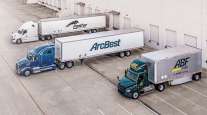ArcBest to Augment NFMC Classification System With Dimensional-Based Pricing
ArcBest, the Arkansas-based less-than-truckload carrier, said it is joining the latest freight shipping trend by adding space-based minimum charges as an option for freight shipments beginning Aug. 1.
The action is part of a larger phenomenon in the trucking industry that is introducing cubic minimum charges to LTL shipments.
E-commerce is a huge driver for the industrywide shift because trucking companies risk losing money by wasting space when placing small or odd-sized shipments on trucks heading out in myriad directions. Measuring cubic minimum charges when appropriate, ArcBest is buttressing weight-based metrics with new scanners, or dimensioners.
While the company presently captures more than 90% of dimensional data on its shipped freight, it said that the new scanners will boost that number more towards 100%.
“We plan to be more efficient in how we do it, and our goal would be that, but we know there will be cases where we won’t have the opportunity to always capture the dimensions,” said Danny Loe, chief yield officer at ArcBest.
The company will have 10 dimensional scanners installed by the time the new pricing becomes effective, said the company’s spokeswoman Kathy Fieweger. The pricing will be done in lieu of traditional National Motor Freight Classification pricing, with the company selecting whichever price is greater. NMFC pricing is a commodity-based rating system based on four “transportable” criteria — density, handling, stowability and liability.
Loe said the shift to dimensional-based pricing “is a minimum price we’re willing to accept per cubic foot per shipment.” Packages go through the typical rating process, he said, where they are weighed, classified, checked for discounted pricing and any other criteria configured in a calculation. “Then we compare what the cubic minimum charge would be, and whatever’s higher would be used as the basis for the pricing.”
Analyst Satish Jindel, founder of SJ Consulting Group in Sewickley, Pa., said that the trend ArcBest is tapping is catching on in the industry, but is not yet standard. Several LTL carriers have deployed dimensional-based pricing, he pointed out, including FedEx Freight, Estes Express Lines, Old Dominion Freight Line, and YRC Worldwide, for example. “They’ve been onboard for the last three to four years.”
He added, “Carriers are just announcing it. Until shippers’ contracts are written and modified to recognize dimensional pricing” there will be a bit of a time lag on this. “Seventy to 80% of shipping is done under contract and contracts don’t change overnight,” Jindel said. “But this [announcement from ArcBest] is just a step in the right direction.”
Matthew O’Connor, a spokesman for UPS Inc., said e-commerce was indeed a driver for the service as they started dimensional-based pricing. They have also done what is called “density-based” pricing for “multiple years,” he said.
“We implemented small package dimensional weight pricing effective Dec. 29, 2014, on all domestic UPS Ground packages and UPS Standard to Canada packages. Dimensional weight pricing more closely aligns UPS’s pricing with the company’s costs, which are influenced by both size and weight.”
UPS had previously used small package dimensional weight pricing for all domestic and international air services, and all UPS standard to Mexico ground services and UPS Ground and UPS Standard to Canada packages measuring 3 cubic feet or greater, said O’Connor.
“For freight — LTL only — UPS has used density-based rating methodology in place for multiple years, which is different than small package dimensional weight pricing. I don’t know when dimensional weight pricing was introduced on air shipments,” O’Connor said.
Dennis Anderson, ArcBest chief customer experience officer, said, “E-commerce probably was a boost for us” to make sure “we were getting properly compensated for all shipments.”
Mike Sanders, director of pricing for LTL carrier Averitt Express, said the company is very happy with its dimensional scanners, which are large contraptions that hang from the ceiling.
“We have 12 dimensional scanners located throughout the service area. We started installing the first of those in mid-2015, and will probably continue installing more,” he said. They serve a dual purpose for the company, tracking and capturing data. “We use them to track about 10% of shipments systemwide every night.”




